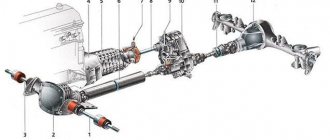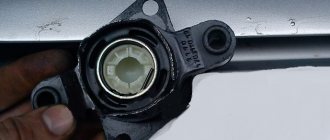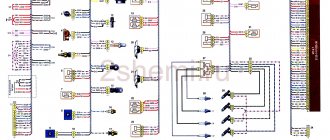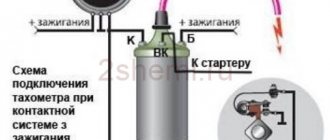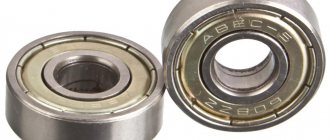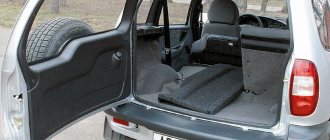The manufacturer installs a 5th manual transmission on the Chevrolet Niva car, which has a 3-shaft design. In particular, there is a drive, secondary and intermediate shaft. The gearbox housing and synchronizer clutches are distinguished by their reliability.
Chevy Niva gearbox
: 1 – input shaft; 2 – clutch release; 3 – front cover with guide sleeve; 4 – input shaft oil seal; 5 – clutch housing; 6 – breather; 7 – gearbox housing; 8 – constant mesh gear of the input shaft; 9 – needle bearing of the secondary shaft; 10 – tray for collecting and draining oil; 11 – synchronizer for 3rd and 4th gears; 12 – third gear gear; 13 – 2nd gear gear; 14 – secondary shaft; 15 – synchronizer of 1st and 2nd gears; 16 – 1st gear gear; 17 – bushing of the 1st gear gear; 18 – intermediate bearing of the secondary shaft; 19 – locking plate of the intermediate bearing; 20 – reverse gear; 21 – nut for fastening the gear selection mechanism; 22 – 5th gear synchronizer; 23 – gear selection mechanism; 24 – fifth gear gear; 25 – support plate fastening bracket; 26 – oil deflector washer; 27 – flange of the elastic coupling of the cardan transmission; 28 – nut; 29 – centering ring seal; 30 – centering ring; 31 – secondary shaft oil seal; 32 – rear bearing of the secondary shaft; 33 – spacer sleeve; 34 – gear block bolt; 35 – gear block bearing; 36 – rear cover of the gearbox; 37 – gear block of 5th gear and reverse gear; 38 – rear bearing of the intermediate shaft; 39 – gear 1st gear of the intermediate shaft; 40 – drain plug; 41 – gear II of the intermediate shaft; 42 – third gear of the intermediate shaft; 43 – lower cover of the gearbox; 44 – intermediate shaft; 45 – constant mesh gear of the intermediate shaft; 46 – front bearing of the intermediate shaft; 47 – clamping washer of the intermediate shaft bearing; 48 – bolt of the clamping washer; 49 – rear bearing of the input shaft.
Chevrolet Niva gear shift control drive
: 1 – support plate fastening nut; 2 – gearbox control drive rod; 3 – hatch cover gasket; 4 – gear shift lever hatch cover; 5 – gear shift lever handle; 6 – gear shift lever; 7 – gear shift lever cover; 8 – sealing cover; 9 – screw for securing the hatch cover; 10 – rear support; 11 – gear shift lever housing; 12 – lower housing of the gear shift lever; 13 – nuts for fastening the rear support; 14 – rear support washer; 15 – nut; 16 – spacer ring; 17 – retaining ring; 18 – ball joint housing; 19 – gear shift lever spring; 20 – ball joint slider; 21 – nuts securing the ball joint housing; 22 – protective cover; 23 – rod end; 24 – support plate; 25 – gearbox.
Chevrolet Niva input shaft diagram
: 1 - retaining ring; 2 - spring washer; 3 - bearing; 4 - input shaft; 5 — synchronizer spring; 6 — synchronizer blocking ring; 7 - retaining ring; 8 - bearing.
Chevrolet Niva secondary shaft diagram
: 1 - retaining ring; 2 - spring washer; 3 — synchronizer hub; 4 — synchronizer clutch; 5 — blocking ring; 6 — synchronizer spring; 7 — washer; 8 — gear III gear; 9 — secondary shaft; 10 - 2nd gear gear; 11 — 1st gear gear; 12 — gear bushing; 13 - bearing; 14 — reverse gear; 15 — thrust washer; 16 — fifth gear gear; 17 — oil deflector washer; 18 — spacer sleeve; 19 — rear bearing of the secondary shaft; 20 - oil seal; 21 — elastic coupling flange; 22 — lock washer; 23 - nut; 24 - seal; 25 - centering ring.
Details of the gear selection mechanism
: 1 — front traction cover; 2 — rod joint axis; 3 — rod joint housing; 4 — thrust eye bushing; 5 — gearbox control drive rod; 6 — front hinge housing cover; 7 - bolt; 8 — guide bar; 9 — guide bar spring; 10 - guide plate; 11 - sealing ring; 12 — gear selector housing; 13 — gear selector lever; 14 - sealing ring; 15 — retaining ring; 16 — ball joint gasket; 17 — seal mounting flange; 18 — washer; 19 - nut; 20 — washer; 21 - spring; 22 — spherical washer of the ball joint; 23 — ball joint of the gear selector lever; 24 - gasket; 25 — guide plate washer.
Parts of the gear selection mechanism control drive
: 1 — ball joint housing; 2 - spring; 3 — ball joint slider; 4 - retaining ring; 5 — gasket of the ball joint housing; 6 — support plate; 7 — gasket of the lower housing; 8 — lower housing of the gear selector lever; 9 — clamp bolt; 10 — washer; 11 — control drive rod clamp; 12 — protective cover; 13 — rod end; 14 — locking stop screw; 15 — axis of the gear selector lever; 16 — toothed washer; 17 — locking stop; 18 — bushing; 19 — spacer sleeve; 20 — gear selector lever; 21 - bushing; 22 — washer; 23 — lever axis nut; 24 — reverse locking pad; 25 — lining bolt; 26 — washer; 27 — sealing cover; 28 — gear selector housing; 29 — rear support; 30 — spacer ring; 31 — rear support washer; 32 — washer; 33 — rear support nut; 34 — washer; 35 — bolt of the gear selector lever housing; 36 — washer; 37 — nut securing the ball joint housing.
Chevrolet Niva gearbox.
It is no secret that to drive a car it is not at all necessary to understand the intricacies of the functioning of its components, but you will have to have a general understanding of them.
In particular, the Chevrolet Niva gearbox is just such a unit, since while driving the driver controls it by selecting the desired gear. Proper operation of the car implies careful treatment of all vital components. Complex mechanical components of the Chevrolet Niva are the engine, gearbox, transfer case, and axle gearboxes. They are designed for a certain resource, that is, the manufacturer guarantees trouble-free operation throughout the declared mileage, provided that the owner complies with all requirements and operating rules.
Regarding the variable gearbox (CAT), you can follow the operating rules only if you know about its functions, design and principle of operation. Every driver receives this initial knowledge in a driving school. Without them, all driving will be reduced to unconscious manipulations, which will lead to a reduction in the life of vital components.
Rear and front gear ratios of Chevy Niva
Gear values for Chevrolet Niva manual transmission from 2002 to present:
To engage the gearbox, you need to move the gearshift lever all the way to the right and push it down with a little force, pressing the gearshift knob in the direction of the rear seats of the car.
The VAZ-2123 gearbox does not have a separate synchronizer for the reverse gear. Accidental engagement of reverse gear is eliminated due to the use of a curved locking stop in the form of a bracket in the design.
Important! The reverse speed of the Niva Chevrolet gearbox, like any car, must be turned on when the car is completely stopped.
In what cases is this procedure necessary?
With proper operation, the gearbox can last quite a long time, since it is a self-sufficient design element that does not require frequent maintenance. On the Chevrolet Niva, the gearbox is designed in such a way as to satisfy the off-road ambitions of the crossover, because initially this car was equipped with all-wheel drive in order to overcome various obstacles. This means that the car’s transmission is designed for increased loads. But it is necessary to take into account such processes as metal fatigue and the production of parts. Over time, under increased loads, the gearbox begins to operate for a long time, experiencing overheating, which leads to expansion of parts and increased wear.
There may be several main reasons when it is necessary to remove the gearbox:
- Dismantling to completely replace the entire mechanism. It is usually rarely used in practice, since in most cases it is possible to repair an old gearbox except in cases where the housing is damaged.
- To carry out maintenance. Components can be cleaned or consumables can be replaced: oil seals, slides or gaskets, depending on the specific case.
- When carrying out other repair work, when the gearbox will prevent access to the desired unit.
Before removing the gearbox, you must carefully study the feasibility of these actions. For processes such as changing the oil, installing a rocker seal or clutch cylinder, removing the box is not required.
Signs of trouble
The transmission is constantly subjected to high loads while driving, especially off-road. At the same time, the parts, despite the lubrication and the safety margin laid down by the designers, wear out intensively. Therefore, failure of the Chevrolet Niva transmission is not at all uncommon. And the point here is not in the quality of the parts, but in the level of loads and complexity of the mechanism.
Symptoms of malfunction depend on which component is experiencing problems:
- Clutch. In case of breakdowns, jerking occurs when starting to move, slipping under load, or “driving” when trying to stop or change gear. Sometimes the malfunction manifests itself in the form of noise when pressing the clutch pedal or in other conditions.
- Gear box. This unit is more complex, and accordingly, its breakdowns are more varied. They manifest themselves in unclear or difficult gear shifting. Oil leaks, crunching noises and extraneous noises are also possible.
- Cardans and intermediate shaft. Here, malfunctions manifest themselves in the form of knocking during acceleration, squeaking or vibration while driving.
- Main bridge. In the event of a breakdown, the mechanism begins to make noise, knocking noises occur when accelerating and oil leaks.
- Transfer case. Problems make themselves felt in the form of spontaneous shutdown of bridges, noise and knocking. There may also be an oil leak.
- Constant velocity joints. Worn parts begin to crunch and knock while driving. The crunch is especially noticeable when the steering wheel is turned hard.
Clutch and gearbox
These units do not differ from the predecessor Lada 4*4 and come in the same housing. The clutch is a dry type, rotation from the flywheel is transmitted through the driven disk to the sprockets of the variable gearbox.
The gearbox is 5-speed, another important difference from the classic Niva is the mounting under the car body and an extended gear shift drive.
Frequent malfunctions are leakage of gearbox seals, so the gearbox body must be carefully inspected for leaks. If the replacement is not carried out in time, due to oil starvation, the 5th gear, located above the other sprockets, will wear out first.
The 2123 clutch is quite durable, but it is better to trust proven imported brands.
Do-it-yourself gear shift assembly adjustment
To correctly adjust the gear selection mechanism you will need a 13 key
You can also try one more method to eliminate rattling and play in the gearbox handle: using a “13” wrench, you need to tighten the lever fastening nut until the axial play is eliminated.
Important! The permissible clearances of the drive unit must correspond to the following values in millimeters: D = 1.5±0.5; E = 1±0.5.
The lever nut must be tightened to a torque of 24.5 Nm (2.5 kgfm).
If, after the adjustment has been made, the same difficulties with gear shifting and vibration remain, this means that this unit is worn beyond the permissible norm and needs to be replaced.
Repairing faults and adjusting the VAZ-2123 steering gear
Bleeding and adjusting the Chevrolet Niva clutch: step-by-step instructions
How to repair a Chevrolet Niva transfer case with your own hands: detailed disassembly instructions
Dismantling the gearbox of a Niva Chevrolet
Gearbox knocking is a fairly common disease and not particularly pleasant. Every time you switch to listen to a rattling sound, you won’t get any nerves. But it is still possible to cure the transmission by carrying out appropriate repairs.
In order to remove the knock of the box, you first need to remove it. To repair the box, you need to have keys (10, 13, 19), a 12 hex key, a screwdriver and pliers. So let's get started:
- Place your machine on a hill or in a hole.
- Disconnect the battery terminal and pour out the oil.
- Get inside the car. Remove the handles from the levers, as well as the transfer cases, the element casing and the cover.
- Remove the casing, boot, lock sensor connector. Remove the gearbox lever itself.
- Set up a gear that reverses, remove the locking sleeve.
- Try to mark the cardan flanges and also the transfer case, so that later you can assemble everything in the correct order.
- Remove the cardan (which is the front one) and the washer (which is the oil deflector).
- Did you see the flange (look at the secondary shaft)? Unscrew the nuts of the elastic coupling from it (this is done with a size 19 wrench).
- Unscrew the nuts on the cushions to the very end of the studs and remove the transfer case.
- Now you need to unscrew the bolts from the cylinder and the starter itself, after first removing the cotter pin and the spring next to it. An extension cord is required for this action.
- And move the starter closer to the radiator.
- Disconnect the sensor that controls the lights (reverse), unscrew the muffler clamp, as well as the bolts from the crankcase and the yoke nuts.
- Unscrew the bolts that hold the box closer to the engine. Carefully disconnect it, just try not to let it hang with all its weight on the input shaft.
- Rock it a little from side to side and gradually move it back until you reach the stop.
- Lower the crankcase down and remove the link from the hole.
Also interesting: How to choose the right tires for a Niva
Installing the car in the inspection hole
Congratulations, you've removed the gearbox! In order to continue the repair, it needs to be disassembled. You should take your time to disassemble it; immediately prepare a work space for yourself. Advice, lay out all the removed parts exactly in the order in which you remove them, this will greatly simplify the reverse process. As you disassemble the device, observe how the bearings, gears, axles behave, whether there are any abrasions, how the input shaft behaves.
You may not have to completely disassemble the element, for example, identifying wear on the bearings is very simple, when you remove the bottom cover, move them a little, if any of the bearings move, it means it is worn out and needs to be replaced. So, let's continue the renovation. You need to do the following:
- First, unscrew the shank nut. Carefully remove the helicopter flange and the mechanism that selects the gear. Check the linkage for cracks.
- Now remove the cover from the back. If you suddenly cannot remove it, then push the bearing race down. It is by looking at the races that the condition and nature of the bearings are examined. If you decide to replace them, then you will need to pierce the bearing (now the secondary shaft) down, remove the clutch housing and check the spring washer.
- Now take out the clip, the bushing (which is remote), and the washer. You will have to disassemble the locking mechanism. To do this, unscrew the gear bolts, as well as the bolt (look at the secondary shaft). Lastly, remove the fungus and the ring.
- Remove fifth gear completely. Disassemble the gear. Take out the fixing ball; to do this, you need to push it inside. Unscrew the third and fourth speed fork bolt, extend the rod, remove it and the cracker. Remove the fixing ball and cracker. And by analogy, disassemble the first and second gears.
- Unscrew the fifth speed fork. Remove the rear gear. Don't forget to check the play.
- Take out the middle bearing, remove the front one, move the shaft back, and then pull it forward. The clip that is inside needs to be knocked down with a chisel.
- Remove the first, second, third and fourth gear forks. Also remove the input shaft, the locking ring needs to be removed, use a hammer or puller for this. Take pliers and remove the ring. Carefully inspect the needle bearing.
- Rocking from side to side, remove the bearing. The shaft needs to be removed. Remove the first and second speed gears, as well as the first, second, third and fourth hub couplings. If you find any malfunctions, you need to release the stopper and remove the third and fourth hub of the third speed. Replace the seals.
Problems with the box
The Niva Chevrolet car, and in particular its gearbox element, as they say, is good, but with its own “peculiarities”. Somewhere after the first 50 thousand km, the device begins to show its teeth. There may be a hum or unusual noise. Such “features” make it clear that the bearings or gears are worn out. If you watch the gearbox for some time, you can determine what exactly needs to be replaced. What other problems can occur with the gearbox?
- Noise, grinding or knocking when the car is moving, and sometimes when warming up.
- Shocks when changing gears.
- The gearbox may refuse to disengage a particular gear.
- Deformation of the lever, which promises complications during the gear shift process.
- Also, transmissions can simply be knocked out.
For each item listed above, there are reasons and ways to solve them. But today we will look at a specific problem - the knocking of the Niva Chevrolet gearbox and we will carry out the repair ourselves.
A knocking sound when the car is moving or when warming up indicates that the bearings, gears, shaft (primary) or axial ones in the gearbox have worn out. Actually, determining what exactly was the reason is sometimes very difficult. And if you do not have the opportunity to completely replace the gearbox, then your only option is to remove the device manually, disassemble it and carry out minor repairs.
Is the gear selection mechanism from Classic suitable for VAZ 2123?
In the modern world of developed technologies, equipment and a huge number of spare parts offered by stores, garage buyers and tuning enthusiasts have access to any actions to repair, constructively alter and modernize their cars.
The manual transmission for the VAZ-2123 car is based on the classic gearbox for the VAZ-2107 with several differences:
If you are faced with a breakdown of the factory gearbox on a Shnivy, and buying a new unit is too expensive, then you can choose a good used version of the classic gearbox and make several modifications yourself.
Tips for replacing the gearbox
Initially, it is necessary to dismantle the factory gearbox with all adjacent mechanisms (muffler, cardan shaft and exhaust shaft). Dismantling is carried out with speed 1 turned on. To install a 4-mortar from a classic, you will also need to rearrange the gear shift assembly itself (shift lever and rocker), and the reverse gear release tab (for this you will have to remove the rear cover).
When moving the gear selector from one gearbox to another, we recommend changing the restrictive retaining ring.
You will have to tinker a little with the rear support crossmember of the gearbox to the body because... classic won't do. The hole for the speedometer cable can be plugged with a rubber seal selected to size.
Useful! When replacing the gearbox, it is recommended to replace all seals and gaskets. Also, with the speed release assembly removed, pay attention to the condition of the clutch release bearing. If necessary, it is easier to replace it while everything is disassembled and accessible.
Gear shift mechanism
The gear shift mechanism of the Niva Chevrolet SUV is due to the presence of a plate with cutouts. The cutouts are rectangular in shape and there are eight of them. The mechanism also includes: two washers (upper and lower), a lever and the main body. All these box components are held together with three bolts.
The position selection mechanism is based on three pins that are held on the back cover of the box. The “neutral” position is between the third and fourth speeds and is achieved by two pairs of bars with spring guides. The plates are located in the grooves of the guide plates due to which a mechanical effect is provided on the lower end of the lever.
The control drive is based on three rods, which are interconnected with forks. The engagement of forward gears is ensured by the fact that the forks fit into the holes of the sliding clutches. The reverse gear is activated by the fork entering the hole of the intermediate gear.
On the ancestors of the Niva Chevrolet SUV, there was a possibility of introducing a rear instead of a fifth. On modern models this possibility is excluded. An exception is provided due to the presence of a blocker, which is attached to the fork of the rod end. The locking mechanism is attached to the gear shift lever of an SUV.
To engage reverse, you must depress the clutch, and then press the shift lever down and move it to the “R” position. The mechanism for engaging the rear is provided by lowering the locking stop to a position below the locking pad. When the speed is turned on, they are lubricated by splashing oil in the box. To avoid oil leakage from the gearbox from the primary and secondary shafts, these places are sealed with oil seals, which periodically require replacement.
Gear shift diagram for Niva Chevrolet
On most passenger cars, the switching pattern is identical. The exception is the inclusion of rear and fifth speeds, but on rear- and all-wheel drive vehicles of the VAZ family this order is always the same. So, let's look at the location of all the gears in the box and how they are engaged. Below is a diagram that will make it easier to understand.
Once behind the wheel, the driver sees not one lever under the dashboard, but two. In this situation, we are interested in lever number “1”, since it is the basis of switching. Lever “2” is designed to engage the differential locking of the wheels, but you can read more about this in the article about differential locking.
So, as you can see, the scheme is standard, the first four speeds are the main ones and are turned on in turn. To engage fifth speed, move the lever to the extreme right position and press forward. To engage the rear, you must still press the lever down in the neutral position, then move it in the same way to the right position and press it back. Thus, a certain position of the lever on the Chevrolet Niva is activated; below is a table corresponding to the optimal speeds for each gear, which will be very useful for beginners to know.
Removing and adjusting the Chevrolet Niva gear selection control drive
If the speeds are turned on very slowly, or a speed that does not correspond to the position of the lever is turned on, you can try adjusting the mechanism.
Gearbox control mechanism VAZ 2123 / rocker / 2123-1703050
Niva Chevrolet backstage adjustment. Malfunction: The gear shift lever began to float First gear does not engage if...
On most cars, this element is a fairly reliable mechanism that can easily last up to a thousand. After dismantling the housing, the gearbox shaft is removed from it.
In the engine compartment, tighten the pinch bolt on the gear selector rod to the required torque. By moving the drive rod relative to the shaft of the gear selection mechanism in the longitudinal direction, ensure that all gears are clearly engaged.
Repair and replacement of the gearbox on a Chevrolet NIVA The gearbox rocker is an element of a multi-link assembly designed to connect the gearbox lever with a rod suitable for the power unit. This part is susceptible to contamination and moisture forms on it. Over time, the quality of lubricant in rubbing parts deteriorates and they begin to wear out, which leads to various problems.
Compared to other elements of the gearbox, the rocker or control rod is a relatively simple mechanism. But for the transmission system to operate correctly, close attention should also be paid to the condition of the linkage - timely repairs and adjustments to the drive traction.
On a Chevrolet NIVA car, this element is a very reliable mechanism that can last up to kilometers without replacement. In fact, there is nothing difficult in choosing a component.
Poll Can you replace the rocker in your car yourself?
Yes, I don’t see anything complicated about it No, I can’t do this labor-intensive process Thanks to these instructions, I’ll replace the slide myself Loading However, there is also a negative side.
In addition, despite Italian quality, these components of the transmission system are more susceptible to wear and tear.
To remove the gearbox you will need: Place the car on an inspection ditch or a lift. Installation of the gearbox on a Niva Chevrolet is performed in the reverse order of removal.
Reasons for withdrawal
Everyone knows that the gearbox on cars is the most unpretentious product, but only if you handle it correctly. Let's start from the beginning: the Chevrolet Niva is an all-wheel drive SUV, which, from the very design, was prepared for a track with various types of obstacles. In the video, but you can easily do everything yourself to replace the front struts. Overcoming obstacles means loading the car, and many problems arise from the loads and overloads of the vehicle, in particular, parts of the engine, gearbox, clutch, etc. fail.
Thus, the reasons for dismantling the gearbox may be as follows:
- Removal for subsequent replacement of the entire mechanism. But it’s immediately worth noting that a new box is installed only if the old one is completely unusable. But this doesn’t happen often, only on cars with high mileage.
- For carrying out repair and cleaning work. This work may include: replacement of failed components, gaskets, scenes and other products. replacing the timing chain on a 1.2 Skoda Fabia engine. Brief content and do-it-yourself repairs without using special tools my page in. Chevrolet Niva car. Gearbox on a Chevrolet Niva. On the Chevrolet field with your own hands. It all depends on what was disabled.
- When carrying out repair work on other vehicle components, if the gearbox interferes with these activities.
We won’t take a long look at what you already know, but let’s get straight to the process of dismantling the gearbox on a Chevrolet Niva.
Before you begin the process of dismantling the gearbox, you will need to make sure that this activity is necessary. For example, to change the oil in the box or replace the clutch slave cylinder, you do not need to remove it.
How to remove engine and transmission protection?
The standard equipment of the Chevrolet Niva includes protection in the form of a curved steel plate. This part prevents damage to the engine crankcase and the most critical elements of the transmission. Below it is a mudguard that prevents road dirt from entering the engine compartment.
However, the protection prevents maintenance of the gearbox and front axle gearbox. Therefore, to change the oil or repair key transmission elements, the plate must be removed. To do this, you will need 8 and 10 socket wrenches.
A necessary tool.
During the process of dismantling the box you will need
- set of wrenches for bolts 10, 12, 13 and 17.
- Set of hexagons from 12 and above
- Container for collecting used oil
- Pliers, Phillips and slotted screwdrivers
- A special stand, suspension or assistant to support the gearbox.
After you have collected all the necessary tools, you can proceed to the actual work.
Design and principle of operation
The service life of drive parts depends on compliance with maintenance regulations. The operating manual states that the mileage before transmission repair is 200 thousand kilometers. In practice, this does not apply only to CV joints, which often have to be changed even with less mileage. As for the gearbox and transfer case, according to the owners' reviews, they can withstand the required 200 thousand kilometers without any problems.
Box housing (3). All mechanisms are lubricated with transmission lubricant, so they are located in a sealed crankcase where this lubricant is poured.
Primary shaft oil seal (4) and secondary shaft oil seal (5). It prevents lubricant from leaking where the shaft enters the crankcase.
Gear synchronizers (7, 8, 9). They serve to more clearly engage gears and fix the selected gearing.
The intermediate shaft (6) is designed so that it is in constant engagement with the input shaft. The intermediate shaft houses the gears.
Secondary shaft (2). Is a driven shaft. It also has gears that can move along the axis of the shaft.
The gear selector is the assembly that drives the transmission gear along the output shaft.
The shaft bearings (purple in cross-section) ensure their rotation.
Instructions for removing the gearbox require preliminary preparation of tools.
For repairs you will need:
- wrenches for bolts sizes 17, 13, 12, 10;
- hexagons in a set of 12;
- slotted and Phillips screwdrivers;
- pliers.
Pre-prepare a container into which the used oil will be collected. You need to find a stand or hanger to support the gearbox. To remove the part, it is recommended to use a special lift or place the vehicle on an inspection hole.
To eliminate the risk of a short circuit when dismantling the part, it is recommended to first disconnect the battery. Preparatory work requires setting the vehicle to the parking brake. When using an inspection pit for work, it is necessary to block the wheels with shoes.
Removing the gearbox
Before you begin dismantling the box, you need to check whether the gear shift mechanism is really the source of the noise. It often happens that unusual noise is caused by loosening of the Niva Chevrolet gearbox covers or defects in other components of the car. The gears may be knocked out due to a loose nut on the shank of the box.
If, when draining the oil from the Niva Chevrolet gearbox, it is discovered that there is very little of it, replacing gears and bearings may not be cost-effective. In this case, it is better to replace the entire box, and in the future carefully monitor the level of lubricant in it.
But the gearbox will have to be removed anyway. To work you need to stock up:
- keys at 10,13, 19;
- hex key 12;
- screwdriver;
- pliers.
Maintenance Recommendations
The cause of the malfunction may be the exhaustion of the intended resource, but most often it lies in non-compliance with basic recommendations for operation and maintenance. Routine maintenance includes only timely replacement of transmission lubricant. It needs to be changed every 40 - 45 thousand kilometers.
Repairing a box is an expensive proposition. It often has to be carried out at a service station, so it is necessary to periodically check the oil level in the gearbox and inspect the crankcase for leaks.
Read news about the new Niva
- Chevrolet Niva gearbox diagram video
- Chevrolet Niva gearbox diagram video
- Chevrolet Niva fuse box with description (up to 2009 release)
- The modernized Lada Niva Legend (4x4) 2021 was shown on the Internet
- Lada 4×4 Bronto - sales stopped, new details » Lada.Online - all the most interesting and useful about LADA cars
- Description of the instrument panel Lada 4×4 (VAZ 2121, 2131) » Lada.Online - all the most interesting and useful about LADA cars
- LADA Niva – Operating manual – Official LADA website
- Chevrolet Niva gasoline consumption per 100 km
| Device and design, technical characteristics, maintenance |
Gearbox and clutch Niva Chevrolet
The Niva has virtually the same VAZ gearbox, but with minor changes designed to increase the durability of the unit. Firstly, this is the replacement of the VAZ rear bearings of the primary shafts and intermediate bearings on the secondary shafts with similar, but sealed types. This eliminates bearing malfunctions associated with contamination and premature wear. Secondly, the gear shift control drive has been changed. It is easy to notice that in a Chevrolet the gearbox control lever is closer to the driver, which makes control more convenient. This was achieved through the use of an extension with a 250 mm horizontal rod. Gear ratios remain the same, as does the gear shift pattern.
The clutch device in the Chevrolet Niva transmission has undergone some changes and received a number of improvements and more progressive parts from front-wheel drive VAZ cars. o made it possible to make the clutch release plate without clearance with the flywheel, which completely eliminates any adjustment of the free play of the pedal. In addition, the pedal began to be pressed much easier, and the clutch lost several hundred grams in weight.
Location.
On Niva DS is installed on the gearbox. This allows data to be read only while driving, turning off when the engine is in neutral.
The device itself consists of a plastic case, inside of which electronic components are located. For proper operation, it is placed in close proximity to the shaft. There is a built-in magnetic bar inside the shaft that creates electrical signals when rotated.
The product is quite fragile, so when dismantling or installing you must be extremely careful not to damage its body.
Correct shifting of transmission levers on a Chevrolet Niva
To use the lock installed on the Niva effectively, use the following recommendations from experts: When driving on a good quality road surface, install the front transfer case handle in front and the rear handle in the back. The front handle is moved back if the road becomes slippery. Once the slippery area has been passed, switch the levers to normal mode.
If the Niva is stopped, the lock may not engage when the clutch is depressed.
This occurs due to the alignment of the teeth with the gear teeth. How to turn on the transfer case on a Chevrolet Niva in this case? Moving as if on a turn, engage the lock. The differential will turn and the gear teeth will come closer to the teeth. If turning off is difficult, do it while the vehicle is moving, maintaining a minimum speed and squeezing the clutch.
How the cross-axle differential lock works on a Niva is clearly shown in the video: Among domestic car enthusiasts, the Chevrolet Niva is a fairly popular SUV that appeals not only to fans of extreme driving and adherents of measured driving outside the city. Many people know that one of the features of the transfer case switching on in a Chevrolet Niva of this brand is the presence of a transfer case in it.
Using this unit, you can enable downshifting, locking, or two functions at the same time, depending on the conditions.
The question of how the Niva Chevrolet transfer case should be used correctly is of interest to many happy owners of such a vehicle and those who only intend to purchase it. It should be immediately noted that you can engage both the lock and the transmission at the same time using the Chevrolet lever that changes gears. So, the lever switches to the right, and then immediately switches on the transfer case on a Chevrolet Niva to engage a lower gear.
To switch back to higher, the lever should simply be moved.
Using a Niva Chevrolet transfer case, in addition to switching on the transfer case on a Chevrolet Niva, the neutral gear is also switched on, and the car will remain securely in one place. The lock can be engaged at any time - in a normal gear, in a low gear - just switch the Chevrolet lever to the left. When is a low gear used? For what purposes is a transfer case even needed, when does it make sense to engage locking and low gear? Such seemingly simple, but at the same time serious questions will become clear when considering the following example.

